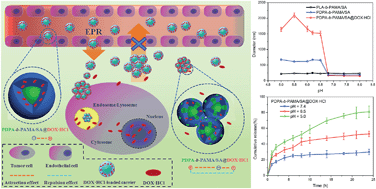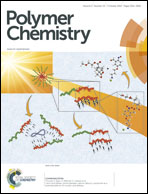Tumor-targeted aggregation of pH-sensitive nanocarriers for enhanced retention and rapid intracellular drug release†
Abstract
Development of nanocarriers, which can selectively accumulate and remain within the tumor tissue matrix, is beneficial for non-invasive cancer diagnosis and therapy. In this study, a well-defined pH-sensitive block copolymer, i.e., succinic anhydride (SA)-modified poly(2-diisopropylaminoethyl methacrylate)-block-poly(2-aminoethyl methacrylate hydrochloride) (PDPA-b-PAMA/SA), was prepared by a two-step atom transfer radical polymerization (ATRP) and subsequent amidation. The low critical micelle concentration (CMC, 40.7 × 10−4 mg mL−1) of PDPA-b-PAMA/SA investigated in pH 7.4 aqueous solution confirmed the adequate thermodynamic stability of its self-assembly. In addition, the pH-sensitive aggregation behaviors of blank and drug-loaded PDPA-b-PAMA/SA were systematically studied at typical pH conditions (7.4 and 6.5) using dynamic light scattering (DLS) and transmission electron microscopy (TEM). Compared with the control sample, i.e., poly(D,L-lactide)-block-poly(2-aminoethyl methacrylate hydrochloride (PLA-b-PAMA/SA), both blank and drug-loaded PDPA-b-PAMA/SA (PDPA-b-PAMA/SA@DOX·HCl) exhibited obvious aggregation through electric interaction between the positive charge of the protonated PDPA block and the negative charge of the PAMA/SA block at tumor sites under slightly acidic condition. Moreover, the drug-loaded nanocarriers exhibited accelerated drug release profiles in response to the acidic condition due to the electric repulsion between the protonated PDPA block and positive DOX·HCl. Cytotoxicity assay results demonstrated that the pH-sensitive block copolymer did not demonstrate obvious cytotoxicity, even at a concentration up to 100 μg mL−1. The enhanced intracellular DOX·HCl distribution in nuclei was also confirmed by confocal laser scanning microscopy (CLSM). Thus, these results suggest that PDPA-b-PAMA/SA provides a feasible platform for efficient tumor-targeted therapy.


 Please wait while we load your content...
Please wait while we load your content...